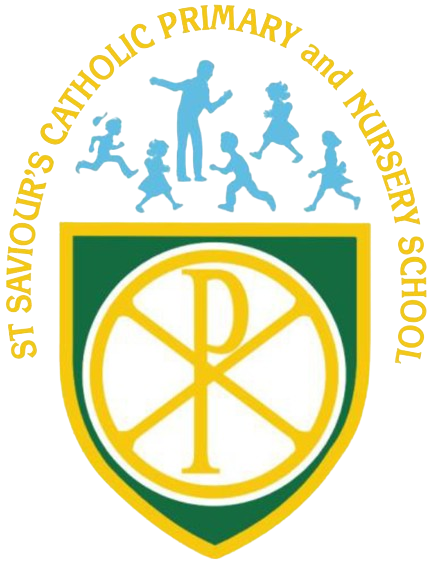Phonics
Intent (Why we learn phonics)
At St Saviour’s Catholic Primary and Nursery School we believe that reading is an essential life skill and we strive to ensure that all children become confident, successful and fluent readers. In order to achieve this, we provide consistent, high quality phonics teaching that helps to foster a love for reading.
We aim for our children:
- To be enthusiastic, inquisitive, lifelong learners: we provide engaging, consistent and structured direct phonics teaching which keeps children enthusiastic and focused, enabling children to become fluent readers and develop a lifelong love for reading, texts are closely matched to children’s stage of phonetical knowledge and understanding and books promote children to be inquisitive and share their ideas.
- To be strong communicators: a good mastery of phonics develops children’s ability to use language confidently within different contexts, expanding their vocabulary as they learn and remember more.
- To be well-rounded, independent and resilient learners with aspirations: we provide opportunities for children to gain confidence to share and explain their ideas, our phonics lessons encourage a strong growth mind-set and resilience within their learning, confidence within reading is a powerful factor in determining a child’s future aspirations and so we aim to help develop this confidence within all of our children.
- To develop and use their God given talents by being creative: we aim for children to develop a strong foundation of the alphabetic code, which enables them to freely communicate and express themselves articulately and creatively within different contexts, fluency within reading will enable children to use their imagination and enter a gateway to endless realms of imagination and creativity.
- To be responsible citizens who are eager to make a positive contribution to their community and wider society: the development of reading and communication skills will enable children to increase their future aspirations.
Implementation (How we teach phonics)
We teach daily phonics through Little Wandle Letters and Sounds Revised which is a systematic and synthetic phonics programme. This progressive program follows a mastery approach and ensures that all children are supported to reach age-related expectations and that learning builds upon their growing knowledge of the alphabetic code.
Using the National Curriculum and the Little Wandle program, we have also carefully mapped out a balance of child-led and adult-led lessons and activities which support children in their communication and language and phonetical skills both within and beyond the classroom. These include daily phonics lessons, practice reading lessons, sharing high-quality stories and poems and learning a range of nursery rhymes and action rhymes.
Throughout daily phonics lessons we ensure quality first teaching for all children by ensuring that, wherever possible, support and feedback is given at the point of learning. Through robust, ongoing assessment, we quickly identify children that have gaps in learning and need additional support. From this, we put into place supportive and structured interventions such as additional lessons, pre-teaching and keep-up sessions. Children with SEN or those which are further behind are supported daily through the Little Wandle SEN program or the rapid catch-up program.
To track pupil progress and attainment in phonics, each children completes a placement assessment and half termly assessments. These assessments, alongside teacher AfL, form our summative data. We then use this to track pupil progress and attainment, set both classroom and home reading books which match the children’s secure phonetical knowledge and group children who may need additional keep-up interventions.
With the support of senior leaders, the subject leader participates in regular, up-to-date training to ensure they have a clear understanding of their roles and responsibilities alongside the knowledge, expertise and practical skills to carry out this role to the best of their ability.
Impact (As a result…)
The impact of our systematic and synthetic phonics programme can be seen in pupil’s ability to decode words with increasing fluency, read GPCs and tricky words successfully taught within phonics sessions, as well as in pupil data and through pupil voice. Everything we do has the child at the centre, and strong relationships are built between pupils and staff, which creates an atmosphere for learning which is conducive to success.
Progress is measured through ongoing assessment for learning, half termly summative assessments are recorded using the Little Wandle assessment tracker tool. This informs planning for future lessons and identifies where further individual or group support is needed. Interventions are planned, implemented and evaluated for targeted pupils.
Through a strong foundation of phonics, we aim to ignite a lifelong love of reading, positive self-esteem and confidence within reading that will remain with pupils throughout their future lives and careers.


At St Saviours- from EYFS through to the end of the autumn term in year 2- we use a systematic synthetic phonics programme called 'Little Wandle’.
All children have daily phonics sessions where they participate in speaking, listening, spelling and reading activities that are matched to their developing needs.
In FS2 and KS1, children are provided with books that are closely matched to their current phonetic awareness level. These are available to practise at home using the webpage below or the Collin EBook app.
https://ops.collinsopenpage.com/sso/login?eulogin=true
-
Little Wandle videos and support materials for parents and carers
Support for parents and carers
Little Wandle Letters and Sounds Phonics Programme






Programme overview Reception and Year 1
Pronunciation guides
- Pronunciation guide Reception Autumn 1.pdf
- Pronunciation guide Reception Autumn 2.pdf
- How to say Phase 3 sounds Reception Spring 1.pdf
- How to say the Phase 5 sounds Year 1.pdf
FS2 - Phase 2 sounds taught in Reception Autumn 1
This Phase 2 sounds taught in Reception Autumn 1 video is designed to be shared with families by schools using Little Wandle Letters and Sounds Revised to help them to support learning at home.
Phase 2 sounds taught in Reception Autumn 2
This Phase 2 sounds taught in Reception Autumn 2 video is designed to be shared with families to help them to support learning at home.
Phase 3 sounds taught in Reception Spring 1
This Phase 3 sounds taught in Reception Spring 1 video is designed to be shared with families to help them support the learning at home.


